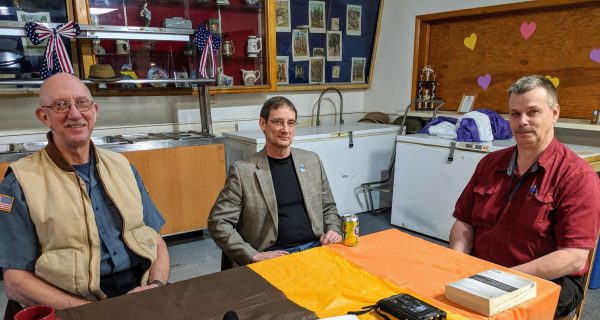
A local group of retired military service members is planning to build a small community near North Pole to give homeless veterans a place to rebuild their lives. The Vet Village would provide housing and job training that project organizers hope will reduce the high rates of substance abuse and suicide among Alaska’s homeless veterans.
Milt Sawyers says he and other Fairbanks-area veterans came up with the idea of building Vet Village as a way to help prevent the estimated 35 ex-service members who live on the streets of Fairbanks from spiraling downward into an abyss of substance abuse and death.
“Our mission is to end veteran homelessness and suicide in Alaska,” he said in an interview last week.
Alaska has more veterans per capita than any other state, and that population continues to rise — as does its rate of homelessness and suicide. Sawyers and other members of the Alaska Veterans Foundation believe the best way to stem that growing problem is to bring those troubled vets into a community operated by other ex-service members who can help their fellow vets in their transition back to civilian life.
“It’s not just a place to park homeless people,” he said. “What we’re looking to do is provide transition-type housing in a community with the essential services that veterans and veterans’ families need to become successful in the Alaskan economy.”
Sawyers says the community’s camaraderie and semi-regimented routine would bring structure to those suffering from post-traumatic stress or other problems. And so would the work requirement that would range from daily chores to gardening and farming, both to grow food for the community and crops like peonies that could be sold to help support it.
“We have a huge agricultural possibility across our state,” he said, “But we don’t have a program to teach veterans how to transition from being a soldier into being a farmer, a rancher or a forester.”
The work requirement differentiates the Fairbanks-area project from Vet Villages that’ve been established in the Lower 48, says Sawyers, a 36-year Army veteran who now works as KUAC’s finance director.
“See, work brings you dignity,” he said. “It gives you purpose. And that’s what’s lacking from a lot of programs.”
“You can give a man some fish, or you can teach a man to fish,” said retired Air Force veteran Jerry Hanson, who’s working with Sawyers on the Vet Village project. “If you give him some fish, when it’s gone, he’s going to starve.”
But, he added, “If you teach a man to fish, a man or a woman to fish, now they become self-sufficient and self-reliant. It’s really that basic.”
Hanson has offered 54 acres he owns near North Pole for the Vet Village site. That’s where organizers plan to build 25 single-occupancy cabins and a central community center-like structure for meetings and events.
“And then along with that would be an agricultural project that involves greenhouses, and would establish really a revenue stream, as well as skills training,” he said.
Anchorage Veterans Foundation member Ric Davidge has been helping develop plans for the Fairbanks-area Vet Village. The former Army medic says building 25 housing units in the first phase of the project gives it enough economy of scale to help pay for itself.
“Once you have 25 living units,” he said, “you then can begin to turn enough money to begin to pay the cost for the operation of it.”
Davidge says by identifying a site for the project, the Fairbanks Vet Village supporters have already overcome a hurdle he’s been wrestling with for five years, since he first proposed building a Vets Village for the estimated 100 homeless ex-service members in Anchorage.
“Oh yeah,” he said. “If you can get the property, that saves you a lot of money.”
Sawyers says the Fairbanks-area supporters don’t yet have a firm estimate on their project’s cost, but he says a similar project in Anchorage was estimated at $1.3 million. He says the group still has more work to do on their proposal, and he says they’ll emphasize the self-sufficient component of its business plan when they begin applying for federal and state grants next year.
Sawyers says if all goes well, the North Pole Vet Village will open within the next five years.
Tim Ellis is a reporter at KUAC in Fairbanks.




